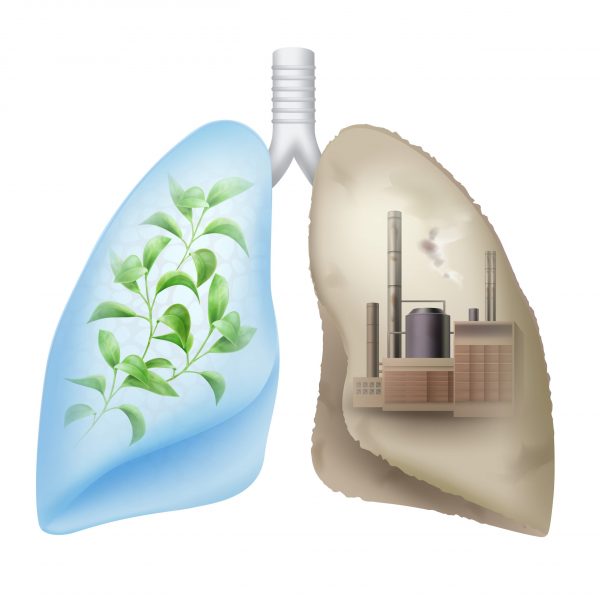Here is an odd and random statistic…
COPD is third highest cause of death here in the U.S., following right on the heels of heart disease and cancer. This means more people die from chronic respiratory disease each year than from stroke, Alzheimer’s, diabetes or influenza.
So I find it strange that people aren’t talking about it.
My patients sure aren’t.
I’ve very seldom had a new patient ask me to test their lung function. Yet they’re clamoring to know about their risk of a stroke. They are concerned they will get Alzheimer’s Disease. They want to know how their blood sugar is. And during the fall season I get more questions about flu shots than almost anything else.
Why aren’t people asking me about the third disease-causing risk of death instead of the fourth, fifth, sixth and seventh?
The truth is people never give a thought to their lung health until they are coughing and wheezing. This is especially true among non-smokers.
But guess what?
Even though smoking rates are at an all-time low, the number of people being admitted to the hospital for COPD is on the rise.
Most COPD Patients Never Even Smoked!
A lot of those COPD patients are people who have NEVER SMOKED! As a matter of fact, it’s estimated that anywhere from nearly one in three (28%) to about two in three (69%) COPD patients are never-smokers.
Those are numbers I don’t want to mess around with. And you shouldn’t either!
So it’s a good idea to start protecting your lungs before they start failing you… and care for them well even if you’ve already received a COPD diagnosis.
I think one of the most important things we’ve discovered in recent years is that all of those disinfecting and fresh-smelling home cleaning supplies advertised on TV aren’t good for you, your family or your pets.
As it turns out, people who use the most home cleaning products show a decline in lung function and experience airway obstruction. This is particularly true in women, who have smaller lungs and lower lung volume to begin with.
This makes it an extremely good idea to start participating in healthy home cleaning practices; without commercial furniture polishes, toilet cleaners and oven degreasers.
It takes only four completely natural items to tackle the huge majority of your cleaning needs – without risk. These are vinegar, baking soda, olive oil and water. (And if you like things to smell good, you can add essential oils to the list.)
These four items can do everything from polishing your furniture to cleaning your oven. Just Google them and you’ll find instructions on how to mix and use them for various purposes.
A Natural Way to Improve Indoor Air Quality
You also have to remember that your house is not hermetically sealed. Whatever is in the air outside of your residence makes its way indoors. So we’ve got all of these airborne pollutants circulating through our homes, whether we want them or not.
One of these is nitric dioxide, or NO2. This is a gas that gets into the air from burning of fuel. So it comes from cars, trucks, buses, boats, tractors and other fuel-burning vehicles. The average level in homes is about half of what it is outdoors.
But there are other factors that can increase NO2 levels in your home. Gas stoves are one. Kerosene heaters are another. Both gas and woodburning fireplaces contribute. So in homes that have these types of appliances, indoor levels of NO2 can actually exceed outdoor levels.
The problem with NO2 is that it aggravates the respiratory system. It worsens conditions like asthma, COPD, emphysema and bronchitis.
Even in healthy people without any respiratory issues, exposure to indoor levels of NO2 can cause inflammation of the airway and increase the chances of damage to airway epithelial cells. It also increases the risk of viral and bacterial respiratory infections.
We get enough exposure to NO2 when we’re sitting in traffic. We don’t need it in our homes.
That’s why I recommend investing in a few houseplants.
Back in 1989 NASA published a paper which found indoor plants can rid the air of certain airborne pollutants, including things like formaldehyde and benzene.
They did all kinds of experiments with a wide variety of house plants. And they found it wasn’t just the green leaves that scrubbed the air. It was the entire plant system – including the roots and potting soil.
According to NASA, some of the best indoor plants for cleaning the air in your house are:
| Bamboo palm | Chamaedorea seifritzii |
| Chinese evergreen | Aglaonema modestum |
| English ivy | Hedera helix |
| Ficus | Ficus benjamina |
| African Daisy | Gerbera jamesonii |
| Corn Plant | Dracaena |
| Snake Plant/ Mother-in-law’s tongue | Sansevieria laurentii |
| Peace lily | Spathiphyllum |
| Chrysanthemum | Chrysanthemum morifolium |
| Pothos/Devil’s Ivy | Epipremnum aureum |
I recommend buying plants with larger leaves for greater purification. And, of course, the more plants you have indoors, the cleaner your air will be. (If you have kids or pets in your house, just make sure to check if there are any toxicity concerns before purchasing.)
I already have plenty of plants in my house. But hey! I think I might buy some more this weekend!
SOURCES:
Lamprecht B, McBurnie MA, Vollmer WM, Gudmundsson G, Welte T, Nizankowska-Mogilnicka E, Studnicka M, Bateman E, Anto JM, Burney P, Mannino DM, Buist SA; BOLD Collaborative Research Group COPD in Never Smokers. Chest. 2011 Apr; 139(4): 752–763.
Arbat S, Arbat A, Agrawal B, Bakamwar S, Deshpande P. Clinical Profile of Nonsmoker Patients with COPD. Chest. 2019 Apr: 155(4), 211A.
Mahmood T, Singh RK, Kant S, Shukla AD, Chandra A, Srivastava RK. Prevalence and etiological profile of chronic obstructive pulmonary disease in nonsmokers. Lung India. 2017 Mar-Apr; 34(2): 122–126.
Svanes Ø, Bertelsen RJ, Lygre SHL, Carsin AE, Antó JM, Forsberg B, García-García JM, Gullón JA, Heinrich J, Holm M, Kogevinas M, Urrutia I, et al. Cleaning at Home and at Work in Relation to Lung Function Decline and Airway Obstruction. Am J Respir Crit Care Med. 2018 May 1;197(9):1157-1163.
Jarvis DJ, Adamkiewicz G, Heroux ME, et al. Nitrogen dioxide. In: WHO Guidelines for Indoor Air Quality: Selected Pollutants. Geneva: World Health Organization; 2010.
Sake H, Goudarzi G, Jalali S, Barzegar G, et al. Study of relationship between nitrogen dioxide and chronic obstructive pulmonary disease. Clinical Epidemiology and Global Health. 2020;8(2):446-449.
Chauhan AJ, Krishna MT, Frew AJ, Holgate ST. Exposure to nitrogen dioxide (NO2) and respiratory disease risk. Rev Environ Health. 1998 Jan-Jun;13(1-2):73-90.
Frampton MW, Boscia J, Roberts NJ Jr, Azadniv M, Torres A, Cox C, Morrow PE, et al. Nitrogen dioxide exposure: effects on airway and blood cells. Am J Physiol Lung Cell Mol Physiol. 2002 Jan;282(1):L155-65.
Wolverton BC, Douglas WL, Bounds K. A study of interior landscape plants for indoor air pollution abatement. NASA. 1989.
Gubb C, Blanusa T, Griffith, A. et al. Potted plants can remove the pollutant nitrogen dioxide indoors. Air Qual Atmos Health. 2022;15:479–490.


